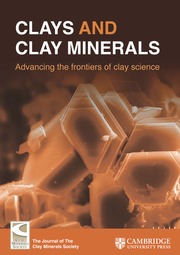Article contents
Influence of pH on the Hydrothermal Synthesis of Al-Substituted Smectites (Saponite, Beidellite, and Nontronite)
Published online by Cambridge University Press: 22 January 2024
Abstract
Smectitic clay minerals are unique indicators of paleoenvironmental conditions and exhibit a unique reactivity in the mineral world. Smectites may exhibit tetrahedral substitutions (Al3+, and sometimes Fe3+, can substitute for Si4+ in tetrahedral sites), resulting in a layer-charge increase, thereby impacting their properties (e.g. swelling and sorption capacities, catalytic properties, expandable abilities). The objective of the present study was to determine the influence of pH conditions on the hydrothermal production of smectite end-members exhibiting tetrahedral Al substitutions (saponite, beidellite, and nontronite), using X-ray diffraction (XRD) and Fourier-transform infrared (FTIR) methods. The results of a series of syntheses conducted at various pH values allowed discussion of the crystallization pathways of these smectites from a mechanistic point of view. Altogether, the present study provided easily reproducible protocols for the hydrothermal production of pure saponite, nontronite, or beidellite (i.e. with no other mineral). The successful synthesis of pure saponite was achieved by exposing the starting gels to 230°C for 4 days in solutions at pH ranging from 5.5 to 14. The successful synthesis of pure beidellite was achieved by exposing the starting gels to 230°C for 9 days in a solution at pH 12. The successful synthesis of pure nontronite was achieved by exposing the starting gels to 150°C for 2.5 days in a solution at pH 12.5. Although extrapolating experimental results to natural settings remains difficult, the results of the present study may be of great help to constrain better the geochemical conditions existing or having existed on extraterrestrial planetary bodies.
Information
- Type
- Original Paper
- Information
- Copyright
- Copyright © The Author(s), under exclusive licence to The Clay Minerals Society 2023
Footnotes
Associate Editor: F. Javier Huertas
References
- 9
- Cited by

